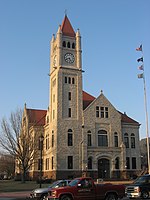Wilberforce University
Wilberforce University is a private historically black university in Wilberforce, Ohio. Affiliated with the African Methodist Episcopal Church (AME), it was the first college to be owned and operated by African Americans. It participates in the United Negro College Fund. Central State University, also in Wilberforce, Ohio, began as a department of Wilberforce University where Ohio state legislators could sponsor scholarship students. The college was founded in 1856 by a unique collaboration between the Cincinnati, Ohio, Conference of the Methodist Episcopal Church and the African Methodist Episcopal Church (AME) to provide classical education and teacher training for black youth. It was named after William Wilberforce. The first board members were leaders both black and white. The outbreak of the American Civil War (1861–65) resulted in a decline in students from the South, who were the majority, and the college closed in 1862 because of financial losses. The AME Church purchased the institution in 1863 to ensure its survival, making it the first black-owned and operated college in the nation. AME Bishop Daniel Payne was one of the university's original founders and became its first president after re-opening; he was the first African American to become a college president in the United States. After an arson fire in 1865, the college was aided by donations from prominent white supporters and a grant from the US Congress to support rebuilding. Later it received support from the state legislature. During the 1890s, scholar W. E. B. Du Bois taught at the university. In the late 19th century, it enlarged its mission to include black students from South Africa.
Excerpt from the Wikipedia article Wilberforce University (License: CC BY-SA 3.0, Authors).Wilberforce University
North Bickett Road, Xenia
Geographical coordinates (GPS) Address Website External links Nearby Places Show on map
Geographical coordinates (GPS)
| Latitude | Longitude |
|---|---|
| N 39.7075 ° | E -83.880555555556 ° |
Address
Wilberforce University
North Bickett Road 1055
45384 Xenia
Ohio, United States
Open on Google Maps








